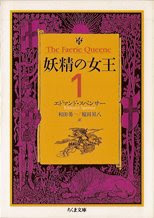I'm back from Belize and the Mayan pyramids of Tikal. While climbing one of them, a (clearly) Japanese guy dropped his sunglasses. I brought them to him and got to say "dou itashimashite" (you're welcome) when he said thank you. The Japanese word for pyramid is 角錐 ("kakusui"). Please add it to your list.
And back to the Faerie Queene:
盾にも、主の加護を仰ぎたいとの
至高の望みから、同じ印が刻まれていた。
tate ni mo, shu no kago o aogitai to no
shikou no nozomi kara, onaji shirushi ga kizamareteita.
盾 - tate we have seen before: shield; tate ni mo is "also on the shield"
主の加護 - shu ("the Lord") is also familiar, but kago means "divine protection" so this expression means "divine protection of the Lord"
を - it's a direct object! always my favorite part of speech since it's easy to identify in every language I've ever learned (even Latin)
仰ぎたいとの - today's first pain in the arse, aogitai (from 仰ぐaogu) must mean "want to revere" but the tono is confusing me for the moment (update: the "to" must be putting the previous phrase into quotation marks, as it were, as a relative clause, hard for me to pick up on, because the "no" following still confuses me, but I guess I'm learning as much as I had hoped!).
至高 - shikou, with the second kanji a common one that means "high," is supremacy
望みから - I like this kanji, comprised of a sound unit 亡 that means "death," and two familiar meaning elements (I presume), 月 "moon" and 王 "king." Parse that as you will, but this verb, from 望む nozomu, means "to desire or wish for." Nozomi, however, is probably just a noun (wish, deisre, hope, whatever) and is also the name of the fastest of the famous "bullet trains" in Japan. I think it goes directly from Tokyo to Osaka. A quick trip to Wikipedia at least confirms that the kanji is the same. I had a student with this name when I taught English in Japan, and we shared quite a few train jokes together (actually I made a train joke every time I saw her, and she put up with it).
から - from (from a desire...)
同じ - the same (very common word)
印 - this character appears in bazillions of little circles on Japanese documents and indicates where you should press your inkan/hanko stamp, your official signature seal. A written signature means nothing there. As technologically-advanced as you may think Japan is, for some reason they haven't gotten away from paperwork in paper form, and legions among any given chain of command must inkan any number of documents, in person, on hard copy, before any decision can be made, before any action will be approved. That said, I love my hanko--the best souvenir I have. In this case, "shirushi" is the pronounciation (as indicated by a helpful gloss, no doubt provided so readers won't ink up their Faerie Queene) and means "mark, symbol, evidence." The が is the subject particle, which leads us to...
刻まれていた - the verb! 刻む kizamu means, according to jisho.org: to mince; carve; engrave; cut fine; chop up; hash (?); chisel; notch. Pretty good range there. I choose notch. We can tell this is our FQ translators' favorite past tense ending from the "-teita" at the end. The "-mare-" bit in the middle indicates to me that this is probably some sort of intransitive, passive form.
I will attempt a translation:
盾にも、主の加護を仰ぎたいとの
至高の望みから、同じ印が刻まれていた。
Into his shield as well, for the protection of the Lord which he wanted to revere
from a supreme hope, the same mark was carved.
...or...
Into his shield as well, from a supreme hope for the protection of the Lord
which he wanted to depend on, the same mark was carved.
The original has an entirely different word order, naturally:
Vpon his shield the like was also scor'd,
For soueraine hope, which in his helpe he had:
Even the English here might seem convoluted, and translating helps to construe it: "The same thing was engraved onto his shield, for the great hope he had of receiving help from the Lord."
All that for just two lines more!
1.20.2009
Subscribe to:
Post Comments (Atom)





No comments:
Post a Comment